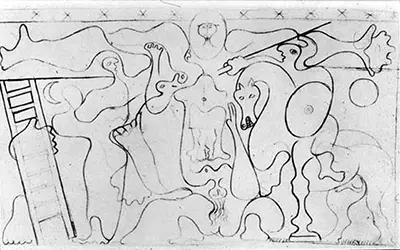A publication from the University of California, the religious art of Pablo Picasso discusses several issues with regards to Picasso’s interest in the religious imagery. The crucifixion was a major theme in Pablo’s life right from a young age as revealed by Timothy Hilton. Apart from the crucifixion study, he also had other religiously inclined paintings in the Early Years period such as The Three Dancers. His 1930 crucifixion painting reveals certain symbolic characters which he again reiterated in the 1934 installment of the same painting.
The common figures in the two images include- a disguised image of the sun on the left and right side of the crucified figure respectively, the ladder, and a picador mounted by a centurion wielding a spear. These images carry a great symbolism around the crucified figure of Christ. Their interpretation brings out the occurrences witnessed at the time of crucifixion as perceived by the Christians.
The detailing in the Crucifixion studies shows evolvement of Picasso’s iconography which was influenced by Grunewald’s Isenheim Altarpiece. Mary Magdalene is seen to have bent over in agony from the occurrence. She has her fingers interlocked just like in the Grunewald’s Isenheim Altarpiece. Consequently, Picasso once again borrows from the form of John the Baptist initially drawn by Grunewald and uses it in this painting. He is portrayed by the character on the right with a finger pointed to show a strong disgruntled gesture.
Another indication of iconographic development in Picasso’s art is the placement of Christ in this Crucifixion study. He is no longer the center of focus since only his legs are shown. Instead, Picasso dwells on the actions, responses, and behavior of the people witnessing Christ’s crucifixion. He brings out ritualistic and ceremonial implications which were not seen in the traditional crucifixion iconography. Even though the images in the study aren’t expressed clearly, Picasso’s interest appears to be in showing the extreme agony brought by the horror of the event. The inclination of Mary Magdalene’s figure, the trickling of blood and chaotic display of observers backs this theory.

